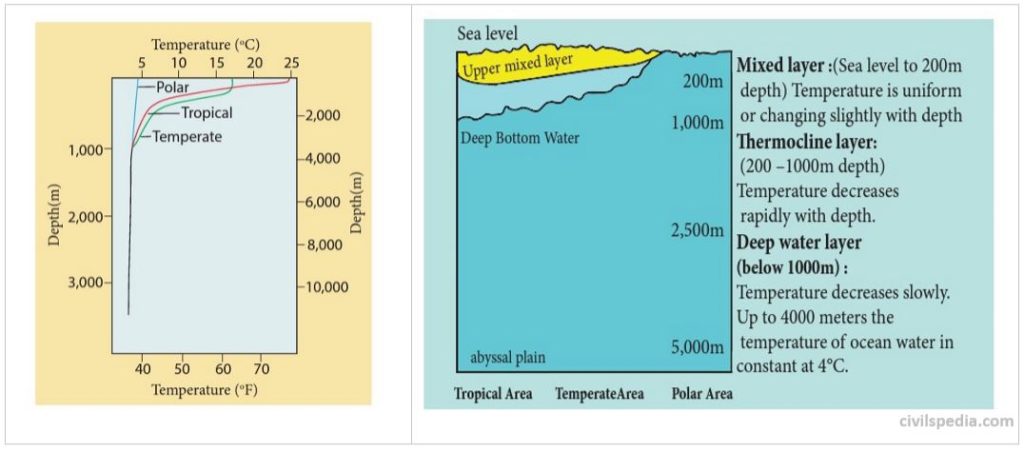Table of Contents
Ocean Temperature
This article deals with ‘Oceanography: Ocean Temperature’ This is part of our series on ‘Geography’ which is important pillar of GS-1 syllabus . For more articles , you can click here
Introduction
- Temperature of ocean water is important because
- Life of Phytoplankton & Zooplankton depend on it .
- Affects climate of coastal lands .
- Points to note :-
- Main source of Energy on Earth is sun ie insolation .
- Oceans play important role in energy & temperature regulation of earth. Because of its specific heat, water doesn’t get heated & does-not get cold very fast . Hence, water can store energy for very long time .
- Average temperature of ocean from surface to bottom is 3-5 Celsius.
- But average surface temperature of ocean is 25 Celsius.
Range of temperature
Daily/ Diurnal range of temperature
- Difference between maximum & minimum temperature of a day.
- Daily range of temperature is almost insignificant in case of rivers & is less than 1 degree C at max
- Tropical water has higher diurnal range than equatorial waters because cooling & heating of water is rapid under clear sky .
Annual range of temperature
Average is 12 degree C but lot of regional variation.
- Higher in case of enclosed oceans than open seas
- Bigger the size lower annual range of temp because of more mixing .
Distribution pattern of Temperature
Studied in two ways

1 . Horizontal distribution of temperature in oceans
Factors impacting horizontal distribution of temperature in oceans
a. Latitudinal Variation
- There is decrease in temperature while going from equator toward poles because of decrease in insolation
- But highest temperature is found not at equator but at tropics
- Reason : High rainfall & cloud cover at the Equator resulting in High Albedo / reflection of sun-rays by clouds
b. Prevailing Winds
Direction of the wind affects the distribution of temperature of ocean water.
- Off shore winds blowing from the land towards ocean or sea raise the temperature of ocean water.
- Winds blowing from snow covered regions in winter lower the surface temperature
c. Hemispheric Variation
- Waters in Northern Hemisphere warmer than Southern Hemisphere . Reason is the oceans in the northern hemisphere receive more heat due to their contact with larger extent of land than the oceans in the southern hemisphere.
- Isotherms in north aren’t regular while in Southern Hemisphere regular.
d. Enclosed Sea
- Marginal seas of tropics ( like Mediterranean Sea) are warmer than open Ocean and marginal seas of temperate region (eg Gulf of Bothnia) are cooler than open sea.
- Reasons
- less mixing of water.
- Land heats up surrounding waters too.
e. Ocean Currents
- Warm currents have warming effect on ocean water
- Cold currents have cooling effect on ocean water
f. Upwelling & Downwelling
- Upwelling – Brings cool water from depth.
- Downwelling – opposite ie warmer .
g. Salinity
- If the sea water is more saline, its temperature will be higher because highly saline water contains more energy on the other hand the temperature of less saline water is low.
Horizontal distribution of Ocean Temperature
- The average temperature of surface water of the oceans at equator is about 27°C and it gradually decreases from the equator towards the poles.
- The rate of decrease of temperature with increasing latitude is generally 0.5°C per latitude
- The average temperature is around 22°C at 20° latitudes, 14° C at 40° latitudes and 0° C near poles.
- The oceans in the northern hemisphere record relatively higher temperature than in the southern hemisphere. The average annual temperatures for the northern and southern hemisphere are around 19° C and 16° C respectively. This variation is due to the unequal distribution of land and water in the northern and southern hemispheres.
- The highest temperature is not recorded at the equator but slightly towards north of it.

2. Vertical Distribution of Temperature of Ocean Waters
- Maximum temperature is on the surface because it receives insolation.
- Transmitted to lower sections of ocean by convection.
- Solar rays can penetrate very effectively till 200m but seldom go below 1000 m . As a result, temperature falls very rapidly from 200m till 1000m & after that , rate of decrease of temperature is very slow (rate & not absolute temperature).
Can be divided into three zones
First layer
- Top layer of warm oceanic water & is 200 m thick.
- Temperature ranges from 20 to 25degree & no large variation with depth ( almost constant )
- Present in tropics throughout year , in mid latitudes in summer & in cold areas never present .
Second layer
- Thermocline layer
- Below first layer from 200m to 1000 m.
- Rapid rate of decrease of temperature to 4 C with increase in depth from 200 m to 1000 m .
- Rate of decrease is rapid at equator & tropics than towards pole because temperature already is very low in Polar Region
- In polar , waters are already at around 4C . Hence, this layer is not present in polars .
Third layer
- Very cold & extend upto deep ocean floor.
- Decrease in temperature with depth is almost nill.
- Polar areas have only this layer from above till ocean floor.

